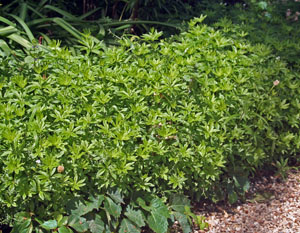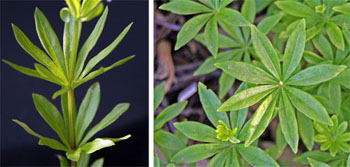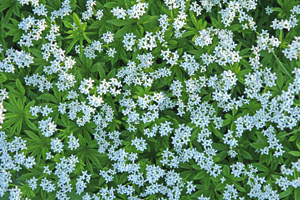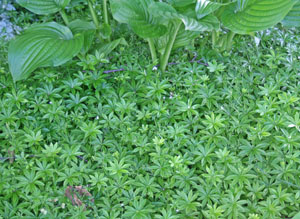
Galium odorata, a spreading perennial with charming early spring blooms and a delicate fragrance, is known by several common names including sweet woodruff, bedstraw, and others. It was formerly placed in the genus Asperula in the family Rubiaceae. Native to northern and central Europe and North Africa, it was traditionally used as an herbal remedy for numerous ailments.

In Germany, the flowers are used to flavor young riesling, called Maiwein (May Wine). The fresh plant has little scent, but as it dries it becomes very aromatic, retaining the smell for years. The dried leaves and flowers – said to have a grassy vanilla odor like freshly mown hay – can be used for potpourri and as a household insect repellant. It was often used in linen cupboards to protect against moth damage. The leaves and stems can be used to make tan or grey-green dyes, while the roots produce a red dye.
Sweet woodruff forms a dense groundcover, growing on a creeping rhizome. The squarish stems grow about 40cm (6-12”) tall. The bright green, narrow, rough textured leaves are arranged in whorls around the stems. The foliage dies back to the ground in most winters in the Midwest and reappears early in spring. It is hardy in zones 4-9.

In spring tiny white blossoms cover the top of the plants. The tubular, star-shaped flowers are borne in small terminal inflorescences held above the foliage.

It spreads readily in ideal conditions, to the point of being considered invasive. Although shallow rooted, it can be difficult to eliminate once established as the fragile stems often break off (leaving the root behind) when pulled unless the soil is very loose. In cooler climates and in clay soils it is better behaved, forming a nice ground cover without taking over adjacent plants. In moist, loamy or amended soils it is much more vigorous and aggressive, and should be used with caution. Many gardeners report it to be a well mannered addition to shady beds, framing adjacent plants rather than running over them. Plant it under larger trees or shrubs, where few other plants thrive so competition is not a concern. It is not susceptible to juglone, so will do just fine under walnut trees.

Sweet woodruff does well in partial to full shade. It prefers moist soils, but will survive in dry shade as well. It is not as lush as when grown with plenty of moisture and more sun. Space plants about a foot apart. It is not favored by deer.
Use G. odorata in a woodland garden or on woodland edges, as a ground cover in dappled shade, or under shrubs or even in the dry shade under pines. It looks great mixed with hostas, bleeding heart (Dicentra spp.) and columbine (Aquilegia sp.). It also combines well with bellwort (Uvularia spp.), European or Canadian ginger (Asarum europeaum and A. canadense, respectively), and hellebores.

G. odorata is most easily propagated by division in spring. Clumps can also be dug and moved throughout the growing season if they are kept moist until established. Cuttings can be taken from mature plants after flowering and rooted in a mixture of peat moss and perlite, but this requires much more effort than division. This species can be grown from seed – and may readily self-seed – but it tends to be slow to germinate when sown in the spring. Cold stratification and leafmold in the soil help speed germination. It is best sown in place as soon as the seed is ripe in late summer.
– Susan Mahr, University of Wisconsin – Madison
– Susan Mahr, University of Wisconsin – Madison
[/cets_callout_box]
Latest from Wisconsin Yard & Garden
Ask Your Gardening Question
If you’re unable to find the information you need, please submit your gardening question here:





 ▶︎ Watch: Fall Bulb Planting
▶︎ Watch: Fall Bulb Planting Aster, Symphyotrichum spp.
Aster, Symphyotrichum spp. Fascinating Fasciation
Fascinating Fasciation Alternatives to Lawn: Groundcovers
Alternatives to Lawn: Groundcovers


